 Triumph Street Triple S - Service manual > Front Brake Master Cylinder
Triumph Street Triple S - Service manual > Front Brake Master Cylinder
Front Brake Master Cylinder - Daytona 675 and Street Triple R
Removal
Warning: Before starting work, ensure the motorcycle is stabilised and adequately supported. This will help prevent it from falling and causing injury to the operator or damage to the motorcycle.
1. Remove the rider's seat.
2. Disconnect the battery, negative (black) lead first.
Caution: To prevent paint damage, do not spill brake fluid onto any area of the bodywork. Spilled brake fluid will damage paintwork.
3. To drain the fluid from the master cylinder, attach a tube to the right hand caliper bleed nipple, slacken the nipple and allow the fluid to drain into a suitable container. Operate the brake lever until all fluid has been expelled.
4. Note the setting of the brake lever adjuster to ensure it is returned to the same position when the overhaul operation is complete.
5. Remove the pivot locknut and bolt securing the brake lever to the master cylinder, and remove the lever.

- Pivot bolt
- Nut
6. Disconnect from the master cylinder the:
- brake hoses,
- brake light switch connections.
7. Release the clamp screws from the handlebar to remove the master cylinder.
Disassembly
1. Support or remove the reservoir.
2. Detach the boot and push-rod from the lever end of the cylinder.
3. Remove the circlip from beneath the boot.

- Circlip
4. Remove the piston set from the master cylinder bore noting the relative position of the seals and piston components.
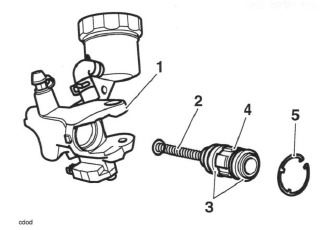
- Master cylinder
- Spring
- Piston seals
- Piston
- Circlip
Inspection
1. Check the following for wear, damage, cracks or deterioration:
- Cylinder bore
- Dust cover
- Spring
- Piston
- Pivot Bolt
2. Always renew the piston and seal set if the cylinder is dismantled.
3. Check that the two ports in the master cylinder bore are not blocked.
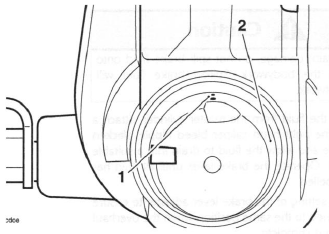
- Ports
- Master cylinder bore
Assembly
Warning: Never use mineral based grease (such as lithium or copper based grease) in any area where contact with the braking system hydraulic seals and dust seals is possible.
Mineral based grease will damage the hydraulic seals and dust seals in the calipers and master cylinders.
Damage caused by contact with mineral based grease may reduce braking efficiency resulting in an accident.
Warning: Before installation, all internal brake components should be cleaned and lubricated with clean new DOT 4 brake fluid.
Never use solvents, petrol (gasoline), engine oil, or any other petroleum distillate on internal brake components as this will cause deterioration of the hydraulic seals in the calipers and master cylinders.
A dangerous riding condition leading to loss of motorcycle control and an accident could result if this warning is ignored.
1. Lubricate the piston and cylinder with new, clean brake fluid.
Warning: Ensure that the piston and piston seal are fitted facing the same way as noted during removal. A dangerous riding condition leading to an accident could result from incorrect assembly of the master cylinder.
2. Fit the new piston set into the master cylinder and retain with a new circlip.
3. Refit the master cylinder boot.
Installation
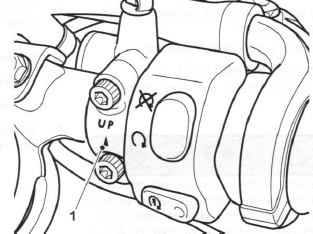
- Arrow mark
1. Locate the master cylinder to the handlebars and position the clamp with the 'UP' arrow pointing upwards. Do not tighten the clamp bolts at this stage.
2. Connect the brake hose to the master cylinder incorporating new sealing washers. Tighten the banjo bolt to 25 Nm.
3. Align the master cylinder/clamp split line with the 'dot' mark on the handlebar.
4. Tighten the clamp bolts, upper first and then the lower to 12 Nm.
5. Connect the brake light switch.
6. Position the brake lever ensuring that the pivot boss is correctly aligned to the push rod. Fit and tighten the pivot bolt to 1 Nm, and the locknut to 6 Nm.
Warning: Use only DOT 4 specification brake fluid as listed in the general information section of this manual. The use of brake fluids other than those DOT 4 fluids listed in the general information section may reduce the efficiency of the braking system leading to loss of motorcycle control and an accident.
Observe the brake fluid handling warnings given earlier in this section of the manual.
7. Fill and bleed the front brakes.
Warning: Always return the lever adjuster to the original setting noted during removal. Operating the motorcycle with lever settings which are unfamiliar may lead to loss of control or an accident.
8. Reset the brake lever adjuster to the original setting.
9. Examine the system for correct operation and fluid leaks. Rectify as necessary.
10. Connect the battery, positive (red) lead first.
11. Refit the rider's seat.
12. Check for correct brake operation. Rectify as necessary.
Warning: It is dangerous to operate the motorcycle with defective brakes; you must have your authorised Triumph dealer take remedial action before you ride the motorcycle again. Failure to take remedial action may result in reduced braking efficiency leading to loss of motorcycle control and an accident.
Front Brake Master Cylinder - Street Triple
Removal
Warning: Before starting work, ensure the motorcycle is stabilised and adequately supported. This will help prevent it from falling and causing injury to the operator or damage to the motorcycle.
1. Remove the rider's seat.
2. Disconnect the battery, negative (black) lead first.
Caution: To prevent paint damage, do not spill brake fluid onto any area of the bodywork. Spilled brake fluid will damage paintwork.
3. To drain the fluid from the master cylinder, attach a tube to the right hand caliper bleed nipple, slacken the nipple and allow the fluid to drain into a suitable container. Operate the brake lever until all fluid has been expelled.
4. Note the setting of the brake lever adjuster to ensure it is returned to the same position when the overhaul operation is complete.
5. Remove the pivot locknut and bolt securing the brake lever to the master cylinder, and remove the lever.
6. Disconnect from the master cylinder the:
- brake hose,
- brake light switch connections.
7. Release the clamp screws from the handlebar to remove the master cylinder.
Disassembly
1. Detach the rubber boot from the lever end of the cylinder.
2. Remove the circlip from beneath the boot.

- Circlip
3. Remove the piston set from the master cylinder bore noting the relative position of the seals and piston components.
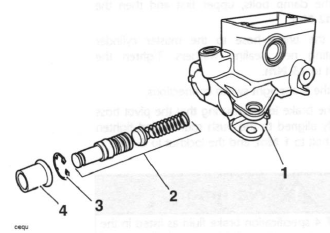
- Master cylinder
- Spring and piston assembly
- Circlip
- Rubber boot
Inspection
1. Check the following for wear, damage, cracks or deterioration:
- Cylinder bore
- Rubber boot
- Spring
- Piston
- Pivot Bolt
2. Always renew the piston and seal set if the cylinder is dismantled.
3. Check that the two ports in the master cylinder bore are not blocked.
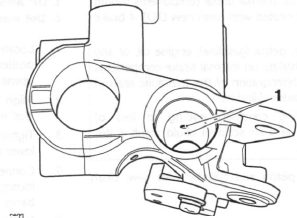
- Ports
Assembly
Warning: Never use mineral based grease (such as lithium or copper based grease) in any area where contact with the braking system hydraulic seals and dust seals is possible.
Mineral based grease will damage the hydraulic seals and dust seals in the calipers and master cylinders.
Damage caused by contact with mineral based grease may reduce braking efficiency resulting in an accident.
Warning: Before installation, all internal brake components should be cleaned and lubricated with clean new DOT 4 brake fluid.
Never use solvents, petrol (gasoline), engine oil, or any other petroleum distillate on internal brake components as this will cause deterioration of the hydraulic seals in the calipers and master cylinders.
A dangerous riding condition leading to loss of motorcycle control and an accident could result if this warning is ignored.
1. Lubricate the piston and cylinder with new, clean brake fluid.
Warning: Ensure that the piston and piston seal are fitted facing the same way as noted during removal. A dangerous riding condition leading to an accident could result from incorrect assembly of the master cylinder.
2. Fit the new piston set into the master cylinder and retain with a new circlip.
3. Refit the master cylinder boot.
Installation
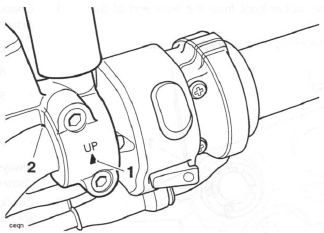
- 'UP' Arrow
- 'Dot' mark
1. Locate the master cylinder to the handlebars and position the clamp with the 'UP' arrow pointing upwards.
2. Align the master cylinder/clamp split line with the 'dot' mark on the handlebar.
3. Tighten the clamp bolts, upper first and then the lower to 12 Nm.
4. Connect the brake hose to the master cylinder incorporating new sealing washers. Tighten the banjo bolt to 25 Nm.
5. Connect the brake light switch connections.
6. Position the brake lever ensuring that the pivot boss is correctly aligned to the push rod. Fit and tighten the pivot bolt to 1 Nm, and the locknut to 6 Nm.
Warning: Use only DOT 4 specification brake fluid as listed in the general information section of this manual. The use of brake fluids other than those DOT 4 fluids listed in the general information section may reduce the efficiency of the braking system leading to loss of motorcycle control and an accident.
Observe the brake fluid handling warnings given earlier in this section of the manual.
7. Fill and bleed the front brakes.
Warning: Always return the lever adjuster to the original setting noted during removal. Operating the motorcycle with lever settings which are unfamiliar may lead to loss of control or an accident.
8. Reset the brake lever adjuster to the original setting.
9. Examine the system for correct operation and fluid leaks. Rectify as necessary.
10. Connect the battery, positive (red) lead first.
11. Refit the rider's seat.
12. Check for correct brake operation. Rectify as necessary.
Warning: It is dangerous to operate the motorcycle with defective brakes; you must have your authorised Triumph dealer take remedial action before you ride the motorcycle again. Failure to take remedial action may result in reduced braking efficiency leading to loss of motorcycle control and an accident.
Bleeding the Rear Brakes, Renewing Brake Fluid
Warning: Before starting work, ensure the motorcycle is stabilised and adequately supported. This will help prevent it from falling and causing injury to the operator or damage to the motorcycle.
1. Remove the cap from the rear bleed nipple.
2. Attach a transparent tube to the bleed nipple.

- Bleed nipple
- Spanner
- Bleed tube
3. Place the other end of the tube in a suitable receptacle containing new brake fluid.
Caution: To prevent paint damage, do not spill brake fluid onto any area of the bodywork. Spilled brake fluid will damage paintwork.
4. Unscrew and remove the rear brake reservoir cover taking care not to spill any fluid.
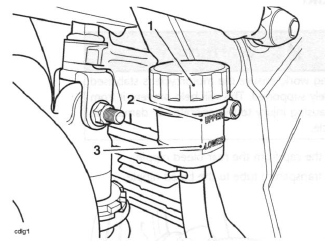
- Rear reservoir
- Rear reservoir upper level
- Rear reservoir lower level
Warning: Ensure absolute cleanliness when adding brake fluid to the brake fluid reservoir. Do not allow moisture or debris to enter the cylinder as this will adversely affect the fluid properties. Always use fluid from a sealed container and do not use fluid from a container which has been opened for any period of time. Always check for fluid leakage around hydraulic fittings and for damage to hoses.
A dangerous riding condition leading to an accident could result if this warning is ignored.
5. Check the condition of the sealing diaphragm.
Replace the diaphragm as necessary.
6. Release the bleed nipple.
Note:
- During bleeding, do not allow the fluid level to fall below the lower level mark in the reservoir. If the level is allowed to fall below this mark, air may enter the system and the sequence of bleeding must be repeated.
7. Slowly depress the brake pedal and, holding the pedal fully down, close the bleed nipple.
8. Repeat steps 6 and 7 until no more air appears in the bleed tube.
9. Maintain the brake fluid level between the upper and lower reservoir levels whilst bleeding is being carried out.
10. When all air has been expelled from the system, hold down the brake pedal and close the bleed nipple. Tighten the nipple to 6 Nm.
11. Fill the reservoir to the maximum level with new DOT 4 fluid.
Warning: Use only DOT 4 specification brake fluid as listed in the general information section of this manual. The use of brake fluids other than those DOT 4 fluids listed in the general information section may reduce the efficiency of the braking system leading to loss of motorcycle control and an accident.
Observe the brake fluid handling warnings given earlier in this section of the manual.
12. Fit the reservoir cover and diaphragm. Check for correct diaphragm fitment before final tightening of the cover.
13. Remove the bleed tube from the nipple.
14. Replace the bleed nipple cap.
15. Check for correct brake operation. Rectify as necessary.
Warning: It is dangerous to operate the motorcycle with defective brakes; you must have your authorised Triumph dealer take remedial action before you ride the motorcycle again. Failure to take remedial action may result in reduced braking efficiency leading to loss of motorcycle control and an accident.
See also:
 Triumph Street Triple S - Service manual > Front Brake Caliper
Triumph Street Triple S - Service manual > Front Brake Caliper
Front Brake Caliper - Daytona 675 up to VIN 381274 and Street Triple R Removal Warning: Before starting work, ensure the motorcycle is stabilised and adequately supported. This will help prevent it from falling and causing injury to the operator or damage to the motorcycle.
 Triumph Street Triple S - Service manual > Rear Brake Pads
Triumph Street Triple S - Service manual > Rear Brake Pads
Warning: Before starting work, ensure the motorcycle is stabilised and adequately supported. This will help prevent it from falling and causing injury to the operator or damage to the motorcycle.

 Benelli Imperiale 400
Benelli Imperiale 400 BMW F900XR
BMW F900XR Honda CB500X
Honda CB500X KTM 390 Adventure
KTM 390 Adventure Triumph Street Triple S
Triumph Street Triple S Yamaha MT-03
Yamaha MT-03 Kawasaki Z400
Kawasaki Z400 Triumph Street Triple S
Triumph Street Triple S Yamaha MT-03
Yamaha MT-03